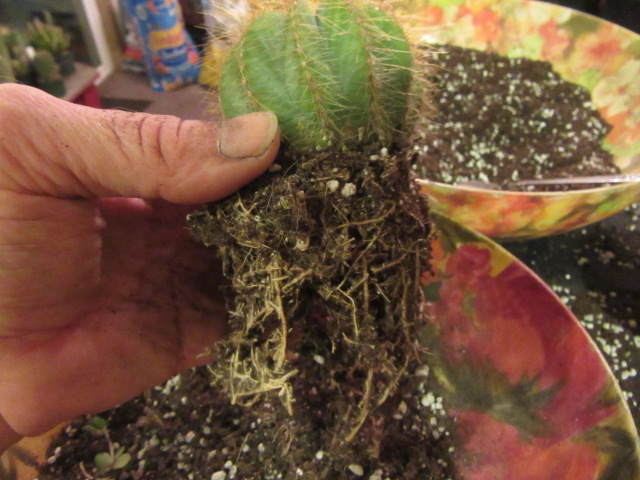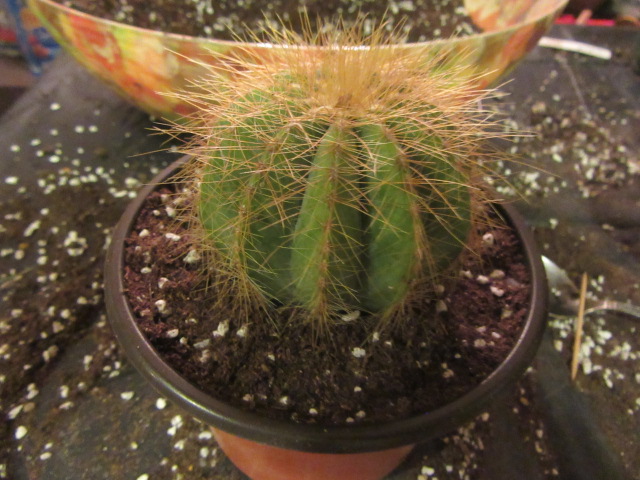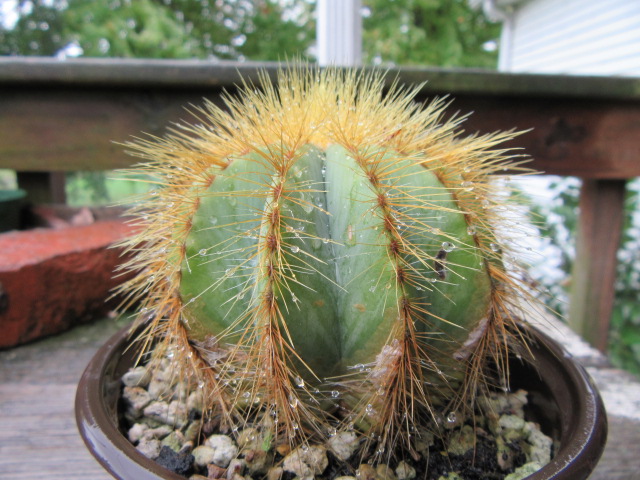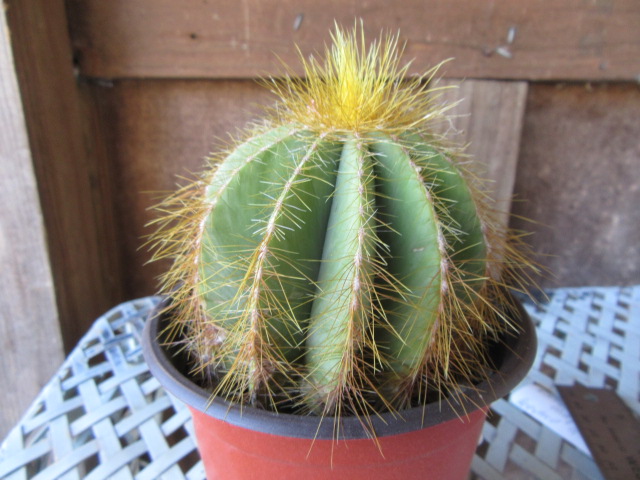
Parodia magnifica on 3-30-19, #557-18.
Balloon Cactus, Ball Cactus, Green Ball Cactus, Blue Ball Cactus
Parodia magnifica
par-ROH-dee-uh mag-NIH-fee-kuh
SYN.
Notocactus magnificus
no-to-KAK-tus mag-NIH-fee-kus
Royal Horticultural Society’s Award of Garden Merit
Synonyms of Parodia magnifica (3) (Last updated on 12-10-23 from Plants of the World Online): Eriocactus magnificus F.Ritter, Eriocephala magnifica (F.Ritter) Guiggi, Notocactus magnificus (F.Ritter) Krainz ex N.P.Taylor
Parodia magnifica (F.Ritter) F.H.Brandt is the accepted name for this species of cactus. It was named and described as such by Fred Hermann Brandt in Kakteen Orchideen Rundschau in 1982. It was first named Eriocactus magnificus F.Ritter by Friedrich Ritter in Succulenta (Netherlands) in 1966.
The label says Notocactus magnificus which is now a synonym of Parodia magnifica. Notocactus magnificus (F.Ritter) Krainz ex. N.P.Taylor was named and described as such by Hans Krainz and ex-author Nigel Paul Taylor in Cactus and Succulent Journal of Great Britain in 1980. Eriocephala magnifica (F.Ritter) Guiggi is also a synonym of Parodia magnifica.
The genus, Parodia Speg., was named and described by Carlo Luigi (Carlos Luis) Spegazzini in Anales de la Sociedad Cientifica Argentina in 1923.
As of 12-10-23 when this page was last updated, Plants of the World Online by Kew lists 68 accepted species in the Parodia genus. It is a member of the plant family Cactaceae with 150 genera. Those numbers could change as updates are made on POWO.
THERE ARE SEVERAL LINKS AND GROWING INFORMATION AT THE BOTTOM OF THE PAGE FOR FURTHER READING.

Parodia magnifica on 3-30-19, #557-19.
I brought this Parodia magnifica home from Lowe’s on March 29, 2019. The label stated it was a Notocactus magnificus but when I did research I found that name is now a synonym of Parodia magnifica.
It was grown by Altman Plants and the label states:
Notocactus magnificus is a beautifully geometric globular cactus from South America. Blue-green globe with wool and golden spines along the vertical ribs. Forms large clustering mounds in time. Lemon-yellow flowers in summer. Protect from frost. Provide bright light; hardy to 20F; to 12” tall. Water thoroughly when the soil is dry.
Parodia magnifica is a native to Rio Grande do Sul in southern Brazil and is also found nearby in Paraguay, Uruguay, and Argentina. The IUCN Red List has them listed as an endangered species. Llifle says they grow on hilly grasslands and on walls between cracks in rocks or in the shade of larger growing plants in deciduous forests. In this climate, they experience warm and cool seasons and grow in soil with plenty of organic matter from the decomposition of other plants. It is said Parodia magnifica can survive temps as low as 20° F if their soil is dry and they are not subject to frost.

Parodia magnifica on 3-30-19, #557-20.
This Parodia magnifica was in an 11 oz. (3 1/2” wide x 3 1/4” tall) pot when I brought it home. The cactus measured approximately 1 3/8″ tall x 2 3/8” wide without the spines at the time. The golden spines on the side of the cactus are approximately 1/2” long and the spines on top are approximately 3/4” long.

Parodia magnifica on 6-26-19, #596-12.
Once temperatures warmed up enough I moved the cactus to the back porch and the succulents and most of the other plants to the front porch. I was fairly busy over the summer so I didn’t take as many photos as usual.

Parodia magnifica at 2 5/8″ tall x 2 5/8″ wide on 10-11-19, #639-80.
I had to move the potted plants inside for the winter on October 11 because an “F” was in the forecast. I always photograph the plats as I move them inside and measure the cactus and some of the succulents. The Parodia magnifica measured 2 5/8″ tall x 2 5/8″ wide. Remember it was approximately 1 3/8” tall x 2 3/8″ wide when I brought it home on March 30.

Parodia magnifica on 10-11-19, #639-81.
Llifle (Encyclopedia of Living Forms) says:
Description: Parodia magnifica is a bluish-green geometric globular cactus with wool that grows in clusters and produces absolutely brilliant yellow flowers. These cacti develop a slight depression on the crown, which may become distorted with age. Parodia magnifica glistens under a haze of pale yellow spines. Cristate (wavy-edged) forms are available but these are usually grafted plants.
Habit: Plants at first solitary, forming large clustering mounds in time.
Stems: Globose, becoming short cylindrical with age, blue-green, glaucous, oblique apically. It grows 30 (or more) cm high and 7-15 cm in diameter.
Ribs: 11-15, straight, symmetrical, acute.
Areoles: White at first, later yellowish close together, or almost contiguous.
Spines: 12-15 or more, bristle-like, thin, flexible, golden yellow, 8-20 mm long.
Flowers: Borne several at a time apically, funnel-shaped, sulfur-yellow, 4,5-5,5 cm long and in diameter; pericarpels with dense white wool and brownish bristles.
Blooming season: Flowering occurs in summer through early fall and will bloom several times during warm weather.

Parodia magnifica from the top on 10-11-19, #639-82.
I find the top of the cactus particularly interesting…

Parodia magnifica roots on 11-13-19, #649-17.
Several cacti and succulents needed to be repotted so I started doing that on November 13. Some just needed their soil changed while others needed bigger pots. I used about 50/50 Miracle Grow Potting Soil and pumice for the mix. I repot any time of the year as necessary, but I have found Fall is a great time. After a summer of regular watering, the potting mixture can become kind of hard when it is decreased. Repotting in the Fall gives the plants nice and loose soil for the winter. In the above photo, you can see the Parodia magnifica had a nice set of roots.
I was trying out pumice because I read that it was preferred by many cactus enthusiasts. One reason was because they say it doesn’t float to the top of the potting mixture like perlite does. Well, it does float to the top just like perlite…
Parodia species grow in southern Brazil in soil with more organic matter. They develop a more extensive root system so they prefer a somewhat deeper pot.

Parodia magnifica on 11-13-19, #649-18.
Some cacti don’t grow a large root system but they still need repotting as the “stem” starts to fill the pot. There was still plenty of soil in the bottom of the pot with this Parodia magnifica but the stem had become almost as large as the pot.

Parodia magnifica on 11-13-19, #649-19.
In years past I would just take the plant from one pot and put it in another without doing anything with the roots. Then later, when I repotted again, sometimes I found the roots still tightly packed in their original wad. So, I started loosening the roots before repotting and sometimes trimming off a few on the bottom. They grow new roots and a little trimming doesn’t bother them. Sometimes you may find rotten or dried roots that need to be trimmed as well.

Parodia magnifica on 11-13-19, #649-20.
Then I always make sure the plants are centered in the new pot.

Parodia magnifica in its new pot on 11-13-19, #649-21.
Here the Parodia magnifica is happy in its new pot… Normally, I only increase the pot size by 1 inch but sometimes I can’t find the right size of pot. I have LOTS of smaller pots so there is always a good selection. You can find pots in quantity on Ebay and Amazon. Of course, you may want a nicer pot…
<<<<2020>>>>

Parodia magnifica (Balloon Cactus, ETC.) at 2 1/2″ tall x 2 3/4″ wide on 10-15-20, #747-91.
I had to move the potted plants inside for the winter on October 15 because an “F” was in the forecast. As always, I took photos and measurements. The Parodia magnifica did very well over the summer and measured 2 1/2″ tall x 2 3/4″ wide (disregarding the spines) on October 15. I took another measurement on November 13 when I was updating this page and it had swelled to 3″ wide! Maybe I goofed in October but I doubt it. I watered the cactus the day before I moved them inside and I think that makes them swell up 🙂

Parodia magnifica (Balloon Cactus, ETC.) from the top on 10-15-20, #747-92.
This cactus is very neat from the top. It reminds me of the crown for Imperial Margarine.
<<<<2021>>>>

Parodia magnifica at 2 1/2″ tall x 3 1/4″ wide on 10-28-21, #853-28.
I didn’t have to move the potted plants inside for the winter until October 28 in 2021. There wasn’t a chance of “F” in the forecast until then which was quite unusual. The Parodia magnifica did very well over the summer and still measured 2 1/2″ tall but it grew to 3 1/4″ wide.
USEFUL INFORMATION:
Family: Cactaceae
Origin: Southern Brazil
Zones: USDA Zones 9b-11(25 to 40° F/-3.8 to 4.5° C)
Size: Hmmm… The label says 12”, Dave’s Garden says 24-36”
Light: Full sun to part shade.
Soil: Fast-draining. Good quality potting soil amended with pumice (50/50) or additional perlite and chicken grit (2-1-1).
Water: Regular watering during the summer. Barely, if any, during the winter.
You can read my Cactus Talk & Update and Cactus & Succulent Tips to get my opinion about growing cacti and succulents.
When you bring your new plants home from the store, you need to check their roots and the soil to see if they are wet. If so, you may want to re-pot it right away. It is advisable to re-pot them in a better potting soil that is more suitable for cacti and succulents.
<<<<2022>>>>

Parodia magnifica (Ball Cactus/Balloon Cactus) at 2 7/8″ tall x 3 1/8″ wide on 10-16-22, #919-32.
I had to move the potted plants inside for the winter on October 16 in 2022 because a “you know what” was in the forecast. I had put the cactus on the front porch with the succulents in the spring to give them a little more shade instead of intense sun on the back porch. The Parodia magnifica (Ball or Balloon Cactus) did very well and grew to 2 7/8″ tall but has shrunk 1/8″ to 3 1/8″ wide. It has a few brown spots that I wasn’t sure what the cause is. I was watching a video on YouTube from Morris Park in the Ozarks where he talked about several issues with his cactus. This could be scarring from getting cold or perhaps from stretching as it grows… Apparently, it isn’t hurting it since it is growing and seems healthy otherwise. The marks are smooth without any sign of any kind of infection, past or present.

Parodia magnifica (Ball Cactus/Balloon Cactus) on 10-16-22, #919-33.
The above photo is an interesting view from the top.
<<<<2023>>>>

Parodia magnifica (Ball Cactus/Balloon Cactus) at 3″ tall x 3″ wide on 10-23-23, #967-32.
Even though there was no “F” in the forecast until October 30, it was going to be a rainy week so I moved the potted plants inside on the 23rd and 24th. Time for photos and measurements…
The Parodia magnifica did very well during the summer on the back porch in full sun despite the heat and drought. It measured 3” tall x 3” wide when I moved it inside for the winter.
I will continue adding more photos and information as time goes by. I have two other Parodia species in my small and growing cactus and succulent collection. They are Parodia crassigibba and Parodia lenninghausii and you can go to their pages by clicking on their names.
I hope you enjoyed this page and maybe found it useful. If you have any comments, questions, or suggestions, I would like to hear from you. Please click on “like” if you visited this page. It helps us bloggers stay motivated. 🙂 You can check out the links below for further reading. The links take you directly to the genus and species of this plant. If you see I have made an error, please make a comment or email me at thebelmontrooster@yahoo.com.